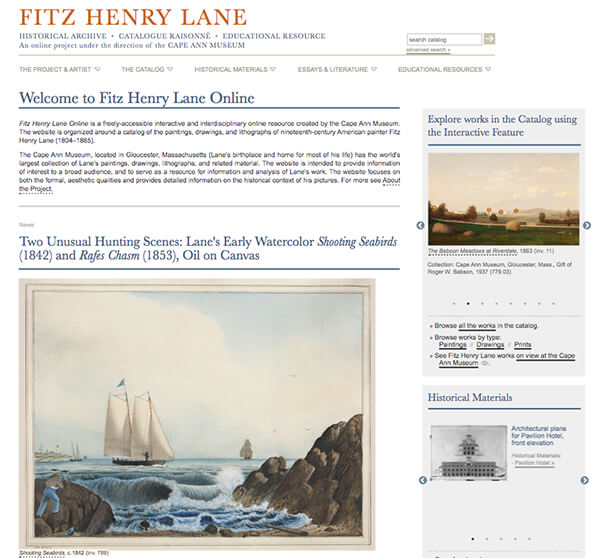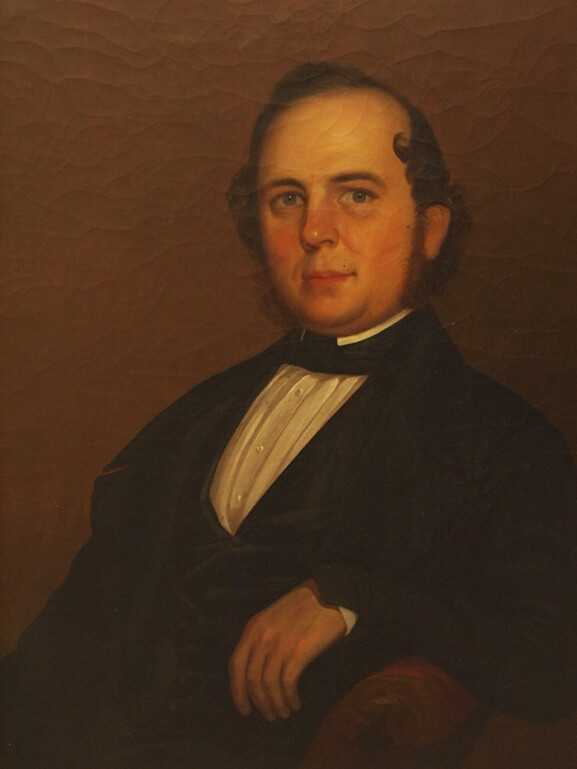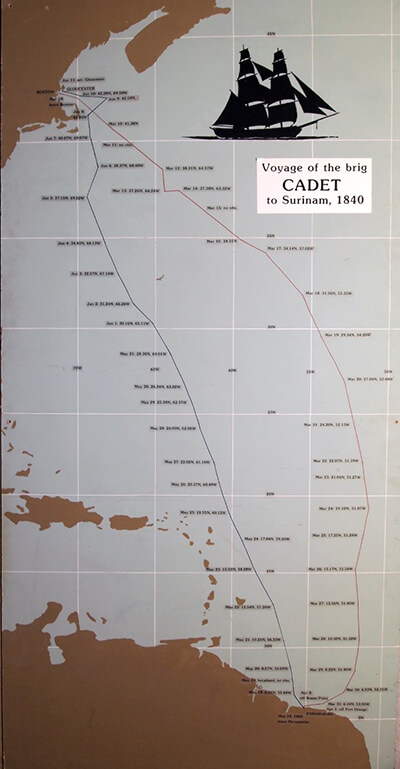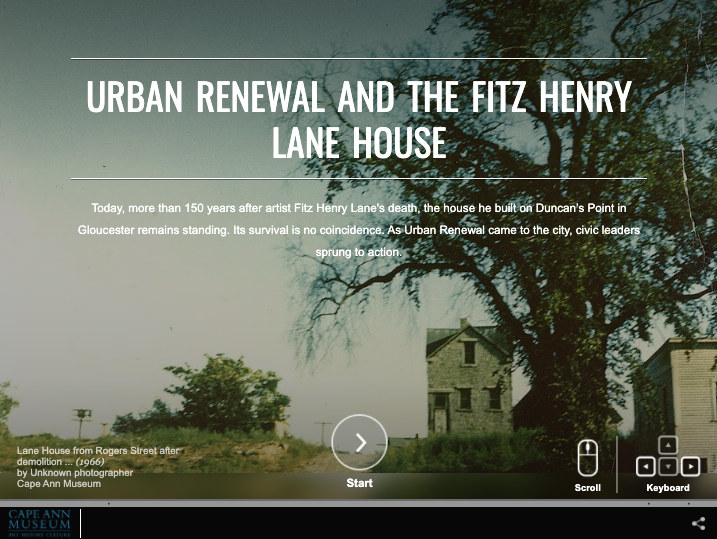Fitz Henry Lane
Drawing from new and on-going research, the Cape Ann Museum's Fitz Henry Lane Gallery reinstallation is complete and once again open to visitors. Exhibits within take a closer look at Lane as a printmaker, a ships' portraitist, and an influential member of the community. In re-envisioning the space, Fitz Henry Lane Online, a freely accessible research tool and online catalogue raisonné of Lane's work, proved invaluable.
In this issue of CAM Connects, we explore the creation of Fitz Henry Lane Online, the connection between Lane’s paintings and the Surinam trade as they relate to Gloucester's maritime history, technological tools that aided in examining his work, and a newly created online exhibition that details how Lane’s House survived during the Urban Renewal era.
We encourage you to make a reservation and come in soon to experience all of these new developments in person. Additionally, our online Museum store now features several publications about Lane and mid-19th century Cape Ann. ■
Fitz Henry Lane Catalogue Raisonné
& Alfred Mansfield Brooks
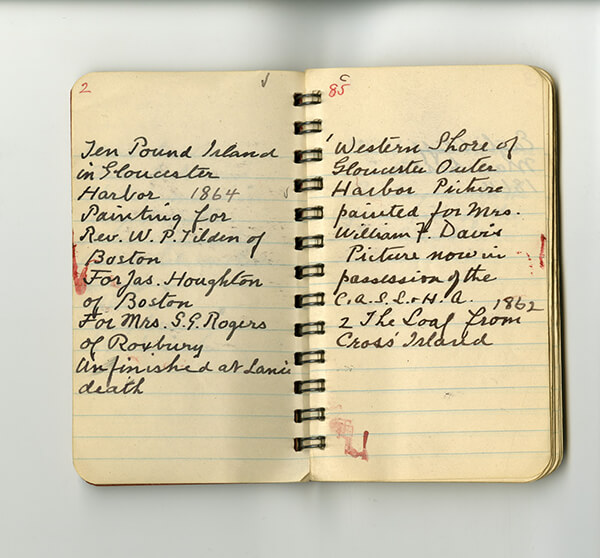
Spiral notebook belonging to Alfred Mansfield Brooks (1870-1963), Collection of the Cape Ann Museum Library & Archive, Gloucester, MA.
Creating a catalogue raisonné is no small feat, especially for an artist who practiced drawing, printmaking, and painting, and had a career spanning over 30 years. With origins as a spiral notebook long before the advent of the internet, Fitz Henry Lane Online was conceived in 2012 and launched in 2016.
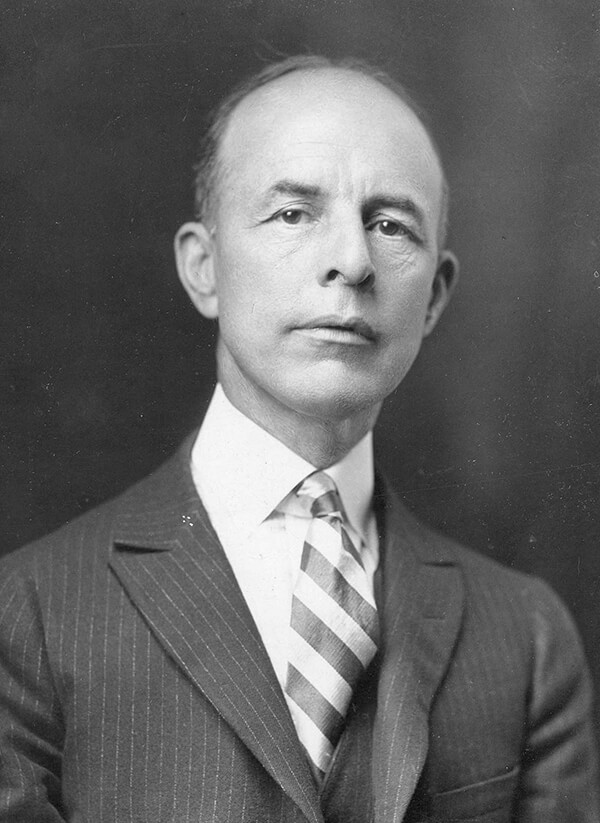
Alfred Mansfield Brooks, c. 1923. Collection of the Cape Ann Museum Library & Archives, Gloucester, MA.
Alfred Mansfield Brooks (1870-1963), long time president and curator of the Cape Ann Museum, laid the groundwork for cataloguing the complete works of Fitz Henry Lane (1804-1865) with this simple notebook. He was responsible for assembling what would ultimately become the largest and finest collection of works by the artist. Today, the Museum’s Lane Collection includes over 40 oil paintings and more than 100 pencil drawings. Thanks to Brooks’ foresight and record keeping, the leadership of Fitz Henry Lane Online Project Director & Editor Sam Holdsworth, and the efforts of countless scholars, educators, curators, collectors, and art historians, Fitz Henry Lane’s works accompanied by supplementary materials providing further context are now freely accessible to anyone with access to a computer and an internet connection. With more than 350 artwork records, an extensive bibliography with website essays, and a treasure trove of historical photos, charts, and artifacts, this evolving resource illustrates the world in which Fitz Henry Lane lived and worked. ■
For more on Brooks and items from his collection in the Library & Archives, read through the collection’s finding aid.
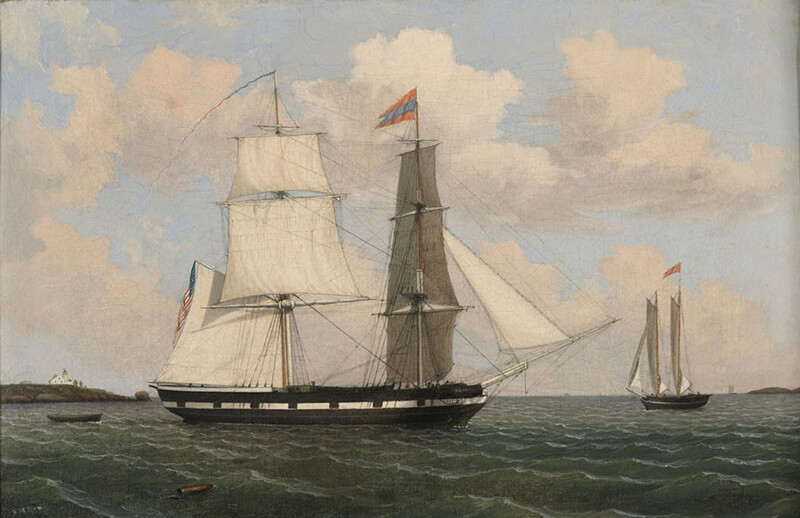
Fitz Henry Lane (1804-1865), Brig “Cadet” in Gloucester Harbor, late 1840s. Oil on canvas. Cape Ann Museum, Gloucester, MA. Gift of Isabel Babson Lane, 1846 [acc. #1147a].
Many of Fitz Henry Lane’s paintings and lithographs are focused on the maritime activities of Gloucester harbor during his artistic career, which began around 1830 and lasted until his death in 1865. Examining them can offer insight into Gloucester’s foreign commerce in the first half of the 19th century, a period that included trade with the Dutch colony of Surinam.
Along with the West Indies, Surinam became a valuable market for salt fish because it was a cheap source of food for the large population of enslaved laborers that worked on the plantations in those colonies. From 1790 to 1840, Gloucester vessels dominated the trade of salt fish with Surinam. Read on to learn more about Surinam’s history and the role that such trade played in Gloucester’s past. ■
Overlay Demonstration of Lane's Works
A few years ago on a beautiful spring day, members of the CAM curatorial team set out to explore some of the sites Fitz Henry Lane painted on the Western Shore of Gloucester Harbor. With camera in hand, they went first to Stage Fort Park and then to Norman’s Woe Cove. After scaling the rocks at each site to find the precise viewpoints from which Lane worked, the team shot several photographs from the same angle. Today, using photo editing software, we are able to overlay these pictures with the paintings and drawings themselves, as well as with the infrared imagery noted in the article below. In this short video, we invite you to follow along as we take a tour through the process. ■
Infrared Technology & Lane’s Paintings

Fitz Henry Lane (1804-1865), On the Wharves, Gloucester Harbor, 1847. Oil on panel. Collection of the Cape Ann Museum, Gloucester, MA. Gift of George O. and Jane Parker Stacy, 1948 [acc. #1289.1b].
In recent years, many of Fitz Henry Lane’s oil paintings in CAM’s collection have been examined using infrared photography, an exercise that has enhanced our understanding of the artist’s working techniques and his artistic development. Much of this work was done by a team of conservators from the Cleveland Museum of Art; they were joined by colleagues in the conservation department at the Museum of Fine Arts, Boston.
An example of one painting by Lane that underwent infrared examination is On the Wharves, Gloucester Harbor, a small oil on panel done in 1847. From the analysis, we now know that a detailed preliminary drawing exists under the paint surface, a drawing to which the artist made several changes as he moved from graphite to paint. We can also see that Lane made use of perspective lines to help organize and strengthen his composition and that he shifted figures shown in the painting and their poses. Additionally, infrared examination has revealed that the ship shown in the painting was drawn out in great detail by Lane, including its rigging and hull planking. ■
To learn more about this important and insightful work, check out this brief essay by Melissa Geisler Trafton, Lead Researcher and Managing Editor of Fitz Henry Lane Online from 2012 through 2016.
The Fitz Henry Lane House During Urban Renewal
Today, more than 150 years after artist Fitz Henry Lane's death, the house he built on Duncan’s Point in Gloucester still remains. As part of the re-installation of the gallery that houses the Cape Ann Museum’s extensive collection of paintings and drawings by this well-known American artist, the CAM Library & Archives has taken a closer look at the history of the Lane House, focusing on its narrow escape from Urban Renewal. Through documents, photographs, and architectural blueprints, this new Google Arts & Culture exhibit reveals how a group of passionate citizens and civic leaders worked for nearly two decades to save and repurpose the house between 1958 and 1977.
Access the online exhibit here. For a closer look at each photograph and document while viewing the exhibit, click the thumbnail in the bottom left corner of each slide.
Unsubscribe | Forward | View in browser
CAPE ANN MUSEUM
27 Pleasant Street, Gloucester, MA 01930
CAPE ANN MUSEUM GREEN
13 Poplar Street, Gloucester, MA 01930
Cape Ann is one of the most important places in the history of American art and industry.
The Cape Ann Museum, thanks to supporters like you, celebrates the history and remarkable contributions of this place to the cultural enhancement of our community and the world at large - yesterday, today and tomorro



